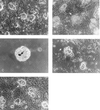Production of zebrafish germ-line chimeras from embryo cell cultures
- PMID: 11226261
- PMCID: PMC30160
- DOI: 10.1073/pnas.041449398
Production of zebrafish germ-line chimeras from embryo cell cultures
Abstract
Although the zebrafish possesses many characteristics that make it a valuable model for genetic studies of vertebrate development, one deficiency of this model system is the absence of methods for cell-mediated gene transfer and targeted gene inactivation. In mice, embryonic stem cell cultures are routinely used for gene transfer and provide the advantage of in vitro selection for rare events such as homologous recombination and targeted mutation. Transgenic animals possessing a mutated copy of the targeted gene are generated when the selected cells contribute to the germ line of a chimeric embryo. Although zebrafish embryo cell cultures that exhibit characteristics of embryonic stem cells have been described, successful contribution of the cells to the germ-cell lineage of a host embryo has not been reported. In this study, we demonstrate that short-term zebrafish embryo cell cultures maintained in the presence of cells from a rainbow trout spleen cell line (RTS34st) are able to produce germ-line chimeras when introduced into a host embryo. Messenger RNA encoding the primordial germ-cell marker, vasa, was present for more than 30 days in embryo cells cocultured with RTS34st cells or their conditioned medium and disappeared by 5 days in the absence of the spleen cells. The RTS34st cells also inhibited melanocyte and neuronal cell differentiation in the embryo cell cultures. These results suggest that the RTS34st splenic-stromal cell line will be a valuable tool in the development of a cell-based gene transfer approach to targeted gene inactivation in zebrafish.
Figures





References
-
- Streisinger G, Walker C, Dower N, Knauber D, Singer F. Nature (London) 1981;291:293–296. - PubMed
-
- Nusslein-Volhard C. Science. 1994;266:572–574. - PubMed
-
- Driever W, Stemple D, Schier A, Solnica-Krezel L. Trends Genet. 1994;10:152–159. - PubMed
-
- Mullins M C, Nusslein-Volhard C. Curr Opin Genet Dev. 1993;3:648–654. - PubMed
-
- van Eeden F J M, Granato M, Odenthal J, Haffter P. In: Methods in Cell Biology. Detrich H W, Westerfield M, Zon L I, editors. San Diego: Academic; 1999. pp. 21–41. - PubMed
Publication types
MeSH terms
Substances
LinkOut - more resources
Full Text Sources
Other Literature Sources
Molecular Biology Databases

